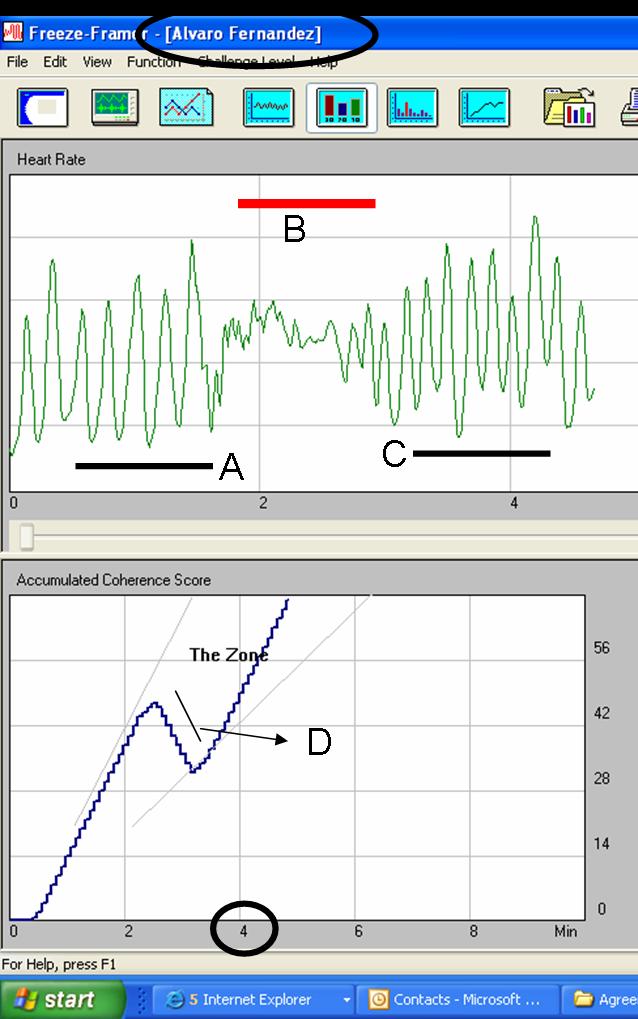Emwave and Emotional self-regulation

In the post Trader Peak Performance and biofeedback programs we showed the Heart Rate Variability patterns correlated with levels of a) anxiety or b) Peak Performance, “The Zone”. Biofeedback supports our emotional self-regulation: we can visually track what is going on inside us and train ourselves to manage our emotional state. On the left you have an example of my own performance during a 5‑minute experiment 4 months ago. At the top, you see my name; at the bottom, the duration of the session. Right axis, for top half, is Heart Rate. (This is only the half left of the screen in the program-the right half would give you more information.) I have highlighted several phases:
A: you can see long waves following a smooth rhythm-that is the physiological “The Zone”, where I can perform at maximum level. I was using breathing and visualization techniques that are sometimes called “The Mental Game” in athletics and sports.
B: I stressed myself. How? well, maybe thinking of a previous boss, or some bad moment in my life. You see that the “waves” disappear, and narrow erratic patterns appear instead.
C: I quickly go back into “The Zone”, using a breathing and visualization technique that works for me. There are many techniques-the virtue of real time visual feedback is that we can find what works for us. The more we train, the better we get at it.
D: the bottom half is showing the cumulative score, and whether I fall inside “The Zone”. The line goes down in the middle because it reflects my anxiety during phase B.
The biofeedback program I used is emWave‚ PC Stress Relief (there is also a handheld device called emWave PSR). It contains several short “videogames” where you have to learn to relax at will in order to succeed. The graph above shows the monitor option-where you can see your Heart Rate and Heart Rate Variability real-time.
Enjoy,
Alvaro



That’s wild. The verbiage didn’t conjure up much of an image, but with this screen shot I can start to see how this system may be able to live up to its promises. What a great idea.
Does the software package include a heart rate monitor? Are there any reviews that you can point us to? What would a typical schedule look like for a new student?
Good it helped to visualize it. I had the same reaction when I first saw the visuals. It gets better when you start to see the real-time impact of your actions and thoughts on the screen-either when you are training or during any normal activity.
ÂÂ
The package includes 1) the software, 2) the sensor (finger one; you buy the ear-one for $25) that measures both heart rate and heart rate variability and connects to your PC, so your PC acts as the heart rate monitor. (HRV, not heart rate, is the predictor of levels of stress/ anxiety, and to measure it precisely requires an algorithm that heart monitors do not have) c) a very informative booklet on managing emotions while playing golf. We don’t have a trading-specific book, but the golf one gives a great overview of what is going on inside our bodies and how to manage it.
ÂÂ
Very recent review:
http://seattlepi.nwsource.com/health/291574_biocompare09.html
ÂÂ
Another one in The Economist a couple of months back:
http://www.heartmath.org/ihm-action/media-stories/soothing-software.html
ÂÂ
Schedule: typically, 3 or 4 times a week, for 5–7 minutes each. The key is frequent practice, so you internalize the techniques and see progress. You could also add 4–5 sessions of 15–20 minutes during the first month in order to get up to speed with the techniques and the program.
ÂÂ
For fun, why not also record what happens during a typical trading session, and analyze it afterwards.
ÂÂ
We will be adding community forums, moderated by coaches, in this website, so it will be easier to share experiences and get advice. Feel free to ask more questions.
That is absolutely marvellous — stress makes you stupid!
Eleanor: nice to see you. “stress makes you stupid!…there is good stress but also bad one, see
https://sharpbrains.com/blog/2006/10/22/is-there-such-thing-as-good-stress/
For the bad one, I agree with your statement, both in the short-term (we can not think well on the spot) and the long-term (because too much stress inhibits learning and harms our health).
Does anyone know of a Mac OS version or another software application like this one?
Hello James, we are not aware of any Mac OC version. There are a couple of handheld devices (one also called emWave, the other StressEraser), with similar technology, but give back less data.
What an interesting experiment. I must confess that I could have used a portable version of one of those biofeedback devices at a few points throughout today. I’ve seen the smaller portable versions, but for me more detail is much better.